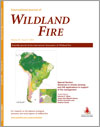International Journal of Wildland Fire
Volume 23
Number 5 2014
RESEARCH FRONT: Advances in Remote Sensing and GIS Applications in Support of Forest Fire Management
This foreword describes advances and challenges for the use of remote sensing and geographic information systems in the operational monitoring and management of wildland fires at local, regional and global scales since the 1970s. Selected articles using remote sensing in different phases of wildland fire management are highlighted.
This paper presents a method to generate fire risk maps making extensive use of geographic information technologies. It describes how the variables were generated and integrated, and how the final index was validated using 2 years of fire occurrence.
This study investigates the selectivity of fire in relation to land cover type and topography in Southern Europe. Shrubland and grassland are more fire prone, whereas agricultural areas and artificial surfaces are less susceptible to burn. There are significant differences between countries and regions. Slopes >25% and north facing ones were less fire prone.
Burned areas were investigated ~20 years after fire events in Greece. Results indicated that the synergy of multi-temporal optical and synthetic aperture radar (SAR) images could provide valuable information for monitoring long-term post-fire vegetation recovery.
This research proposes a process to generate a fuel map for large areas, using the Fuel Characteristic Classification System. Fuelbeds were built to represent fuels across the continent of South America. Fire potentials including indexed values of surface fire behaviour, crown fire and available fuels were computed and mapped, enabling users to assess fire hazard, predict fire behaviour and calculate fuel consumption and greenhouse gas emissions.
We developed an approach to derive continuous maps of daily fire progression using Moderate Resolution Imaging Spectroradiometer (MODIS) active fire and thermal anomaly data. The method outperformed the temporal reporting accuracy of two MODIS burnt area products. Remote sensing data on fire progression have the potential to improve our understanding of climate and vegetation controls on fire behaviour and emissions.
Time series of low-resolution satellite imagery were analysed with the use of the Breaks for Additive Seasonal and Trend (BFAST) method. Trend changes were identified after a fire event in southern Greece, resulting in the mapping of the burned area and illustration of the post-fire vegetation recovery trend.
Two sets of flight trials explored the potential of night vision aids in aerial wildfire detection. One was a controlled experiment and the other part of operational aerial detection patrols. Small fires could be detected and reliably discriminated using night vision goggles from distances compatible with daytime aerial detection patrols.
We studied the surface fire regime in a forest on tribal lands where prescribed burning has occurred since the 1960s. Fire frequency and synchrony were similar, but fire seasonality was dissimilar, between the historical and modern land-use periods. Fuels, climate and human land uses regulated the fire regime over time.
Mathematical models of the trajectory, oscillations, rotation, and mass and size time-evolution of cylindrical wind-driven firebrands are proposed. The total distance travelled by the firebrand is an increasing function of its initial aspect ratio. Particle initial orientation relative to the wind, and its oscillation, significantly influence its trajectory.
Simulation modelling revealed that defoliation by western spruce budworm inhibited the vertical spread of fire into a tree crown as well as the horizontal spread of fire between adjacent trees.
This study aims to improve fine fuel moisture content prediction below fibre saturation of Pinus pinaster dead needles through modelling of sorption processes and equilibrium moisture content. Good fit between the results of combinations of models and laboratory and field measurements was obtained.
Ash crust formation can occur following severe wildfire events. Initial ash composition and a hydrating rainfall event are necessary precursors for crust formation. An ash crust can decrease ash hydraulic conductivity by 1 order of magnitude as well as significantly decrease ash layer porosity and increase bulk density.
We quantified the winter and spring diet of silky mice (Pseudomys apodemoides) and heath rats (P. shortridgei) at sites ranging from 2 to 55 years post fire. Silky mice ate different foods at very recently burnt and mature forest sites whereas heath rats ate similar foods across the time-since-fire spectrum.




